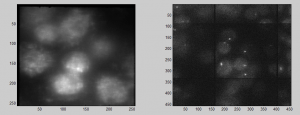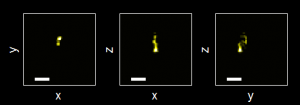11:00 am – 11:50 pm
Chromatin
- attempted imaging new BXC probes and G10 probes
- stains look very bad, spotty background, not good foci. I think I should remake these probes.
Figure making for project 2
- working on figures 3 and 5
- see post.
Applying for Stochastic Physics in Biology Gordon Conference
Abstract for Gordon Conference:
Extensive analyses of the genomes of multicellular organisms have shown that many of the regulatory features of the genome are organized at the scale of kilobases to megabases. The structure of genomic chromatin at this scale however is poorly understood. Here, we present a method to visualize structural organization of regulatory chromatin domains using a high density DNA painting approach coupled to super-resolution STORM imaging. We observe a rich and largely stochastic diversity of spatial conformations across the 80 genomic loci we have imaged and quantified. Midst the stochastic differences, we find several aspects of this structural diversity which correlate strongly with the nature of the local epigenetic marks. For example, both the median volume and median radius of gyration of chromatin domains follow unique power-law scaling as a function of domain length, where the scaling exponent is determined by the epigenetic mark. To better understand both this innate variation and the molecular mechanisms responsible for the different patterns of folding, scaling, and segregation we observe in the data, we present observations from computational models of the chromatin polymer. Together, these results demonstrate a high degree of structural organization at some of the most developmentally important gene clusters, coupled to a notable degree of stochastic variation, both of which place important constraints on the regulation the genes in these domains.
Relevant Activities:
- (not sure what’s supposed to go here, but we’ll give it a try:)
- Attended 1st Gordon Conference on Stochastic Physics in Biology (January 2011, Ventura CA).
- Attended 3rd International Workshop on Stochasticity in Biochemical Reaction Networks (September 2011, Banff, Canada)
- Served as lead organizer of the 4th International Workshop on Stochasticity in Biochemical Reaction Networks (September 2013, Banff, Canada).
- Wrote a review in 2013 on Analytic Approaches to Stochastic Gene Expression in Multicellular Systems (Published in Biophysical Journal).
- Served as a reviewer for PLoS Computational Biology and Biophysical Journal of recent manuscripts published or in press in the field of Stochastic Physics in Biology.


